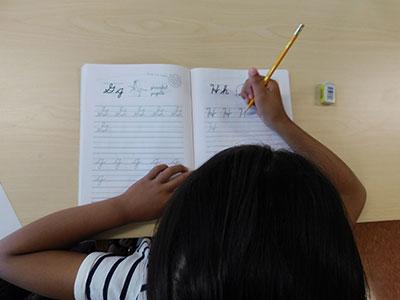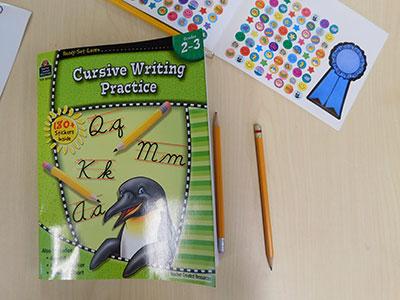Something we notice a lot here at the LP Fisher Public Library (and you probably do, too) is that when many of our young patrons get their first library card they have a difficult time signing the back. And we're not just talking preschoolers who are still learning to form letters — we're talking preteens and teenagers. Sometimes even adults.

The decline of cursive
Here in New Brunswick, cursive writing seems to have been removed from school curriculums, as it has been in most parts of Canada. My eldest son is in middle school and has not learned any cursive in the classroom, and neither has my youngest son in grade one. When their writing isn't done in print format, it is done on a computer or tablet.
Teachers seem to stress writing for subject clarity, not aesthetics (which is in many ways understandable). But this begged me to ask the question, "If they can't write in cursive, how can they possibly read it?"
Why teach cursive at the library?
As both a librarian and a parent, I'm concerned about this generation's literacy. Not being able to read cursive could limit people's ability to pore over old letters and photographs, interpret historical documents, read wedding invitations or doctor's prescriptions, appreciate calligraphy — and yes, sign important paperwork.
Printed block letters are much easier to forge, and many government or banking documents require a scripted signature. There's also a link to physical literacy, as writing cursive creates a kinesthetic feedback loop using our fine motor skills so we remember words as a whole concept, not just individual letters.
Our cursive writing workshops

In an effort to stave off this cursive illiteracy, we began offering cursive writing workshops at the library in 2018 for anyone ages 5 and up. The course is an hour long, free and includes a workbook they get to take home. We usually only take five students at a time so they can get individual attention from the instructor.
First, we practice making lines and loops and warming up our hands with curvy doodles, building up some muscle memory before tackling the harder stuff. Next, we practice a few letters of the alphabet (we don't have time to do all 26 in an hour!), and then the students are invited to practice the letters in their name. We practice linking the letters together and talk about the importance of the "tails."
Then we practice ascending letters (ones that go above the dotted midline, such as lowercase "d" or "h") and descending letters (ones that go below the midline, like lowercase "y" or "p"), and we start linking the letters together to make words. I have them practice writing their birthday month.
I ask the students to notice patterns in their words, and we talk about how letters and subsequently words are symbols that we give meaning to, just like we do with numbers. We discuss how letters and writing and their patterns are not so different from math (STEM programming!). Then we wrap up by writing out the day of the week and month of the year.
Each time a student completes a page in the workbook they get to reward themselves with a sticker from the book. If you didn't have the budget for the relatively inexpensive workbooks, you could always print out free worksheets from the internet.
Everyone really enjoys this program and are happy to take the workbooks home at the end to keep practicing. I highly encourage trying this program out in your own library, for children or adults! Bonus: it improves your own cursive writing skills!



